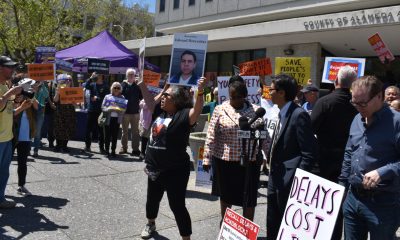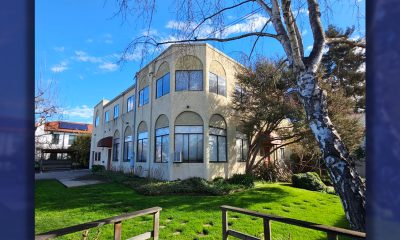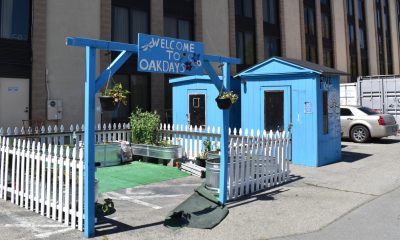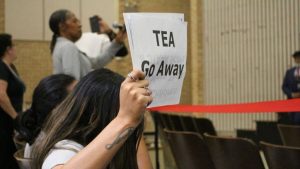Community
S.B. Legal Aid Offers Free Expungement
PRECINCT REPORTER GROUP NEWS — It should come as no surprise that the last place most formerly incarcerated want to be is at another courthouse standing before another judge. That’s probably one reason why thousands that could have gotten expunged haven’t taken advantage of the process locally since 2014 when the expungement law opened up. Since then, Michelle Dodd has handled over 300 cases from start to finish. She takes care of the entire process, and all clients need to do is show up at the door of the Legal Aid Society of San Bernardino.
By Dianne Anderson
It should come as no surprise that the last place most formerly incarcerated want to be is at another courthouse standing before another judge.
That’s probably one reason why thousands that could have gotten expunged haven’t taken advantage of the process locally since 2014 when the expungement law opened up.
Since then, Michelle Dodd has handled over 300 cases from start to finish. She takes care of the entire process, and all clients need to do is show up at the door of the Legal Aid Society of San Bernardino.
And, it’s free.
“They’re going to send you right to me. I’m going to do the paperwork, you’ll come in and sign it. You don’t ever have to see the judge or the court clerk,” said Dodd, case management director at the Legal Aid Society of San Bernardino.
Documents are sent by mail so the client doesn’t have to file. The judge hears it within 30 to 45 days when the order is denied, or approved, via the mail.
With her 90% success rate, mostly it’s approved.
Over the past few years, she has seen several clients come in that need multiple expungements. One client originally had three charges, but had snowballed into 28 parole layered charges. It was a case of violation on top of violation, on top of violation.
“The reality is that they were young. Now they’re older, and all of these are from their past. They were silly charges,” she said.
Youth get tied up in the system from an early age, and probably never learned how, or had an opportunity to clean up their past. Now that they’re older, they have a family to support and they’re trying to get a job.
Despite their checkered backgrounds, some of her clients have been able to land decent work, but she recommends not waiting until the last minute to set the record straight.
One client was up for a job at DMV, but he lost his window of opportunity because his expungement was not even close to being ready. He had to produce proof, but he didn’t realize that he needed an expungement until they notified him.
“They sent him a letter of denial that he had a charge from 23 years ago, and he needed to get it fixed,” she said. “But they only gave him ten days to clear that up before he could reapply.”
It cost him the potential job.
Others have also come in because they are trying to assist their aging parents. Decades later, they can’t pass the background check without an expungement that they didn’t realize they needed.
“They’re thinking I did two days in jail, and got 36 months of probation,” she said. “Now, it’s 20 years later and they can’t get the job because of that charge.”
Dodd, who has worked with Legal Aid nearly 24 years, said the expungement law passed in 2014, but the forms changed in 2017 to re-sentencing language that now involves several different components, including immigration.
Until the laws change, the biggest barrier even with expungement is that the formerly incarcerated still must check the box that they’ve been arrested.
“Once it’s expunged, it says dismissed instead of what the sentence was,” she said. “To get it off the record requires an entirely different motion, and character letters from people [without a] guarantee that’s going through either.”
However, there may be some encouraging changes on the horizon for low-level offenders that have been locked out of jobs, housing or education because of their arrest record.
AB 1076 wants to seal the conviction database of eight million records from public view, but it will be open for certain law enforcement agencies. To pass, it needs to clear both Democratically-controlled houses before heading to Gov. Gavin Newsom to sign or veto in September. If passed, the law would take effect in January, 2021.
“That’s the change we need,” Dodd said.
Assemblymember Phil Ting (D-San Francisco), author of AB 1076, states on his website that the process of automating arrest and conviction relief at the California Department of Justice is the first of its kind.
“Everybody deserves a second chance. We must open doors for those facing housing and employment barriers and use available technology to clear arrest and criminal records for individuals already eligible for relief. There is a great cost to our economy and society when we shut out job-seeking workers looking for a better future,” Ting stated.
According to www.timedone.org, a campaign of the Alliance for Safety and Justice, one-fifth of the 70 million Americans convicted of a crime still struggle with barriers to access jobs, housing, education long after they have served their time.
“The negative impacts of a felony conviction disproportionately impact people of color, people living in urban areas, people without a college degree, and people who are low income. The largest disparities relate to finding a job or housing,” Californians for Safety and Justice reports. “ People of color are 25% more likely than white people to report difficulty finding a job and 61% more likely to report difficulty finding housing.”
For more information on clinic times and document preparation, see http://legalaidofsb.org/
City Government
Vallejo Continues to Accept Applications for Boards, Committees and Commissions
The City of Vallejo is requesting applications to serve on a number of the City’s boards and commissions. Vallejo residents who are interested in serving on an advisory body are invited to submit an application and supplemental questionnaire for consideration.
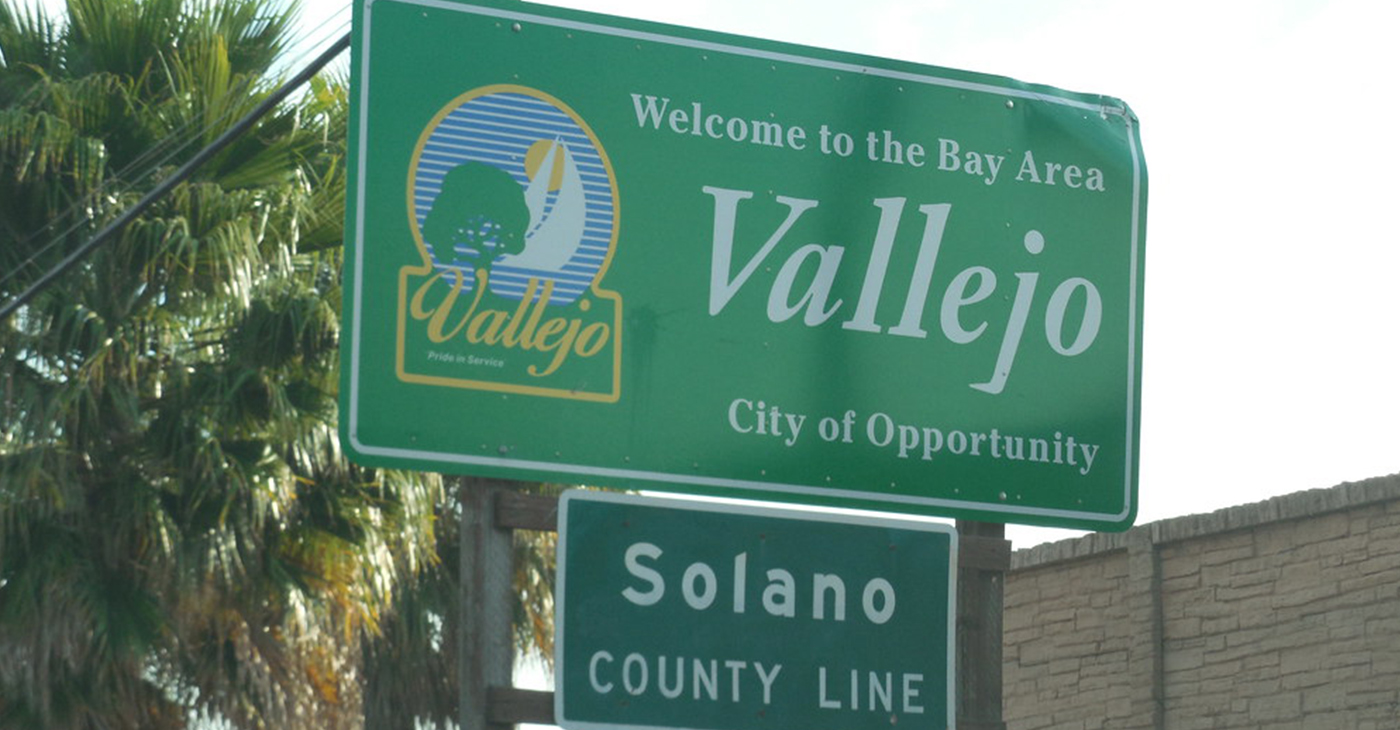
By City of Vallejo
The City of Vallejo is requesting applications to serve on a number of the City’s boards and commissions. Vallejo residents who are interested in serving on an advisory body are invited to submit an application and supplemental questionnaire for consideration.
There are currently openings on the following boards, commissions, and committees:
- Beautification Commission(2) terms expire 6/30/28
- Civil Service Commission(2) terms to expire 6/30/28
- Design Review Board(2) terms to expire 6/30/28
- Housing & Community Development Commission(1) term to expire 6/30/28
- Housing Authority(1) tenant commissioner term to expire 12/31/24
- McCune Collection Commission(3) terms to expire 6/30/28
- Participatory Budget Steering Committee(6 members & 3 alternates) terms expire 6/30/25
- Planning Commission(2) terms to expire 6/30/28
- Surveillance Advisory Board – Districts 1, 2, and 3 Members OnlyDistricts 1 & 3 terms to expire 1/2/25 and District 2 term to expire 1/5/27
- Sister City Commission(1) term to expire 6/30/27
- Solano Commission for Women & Girls(1) Vallejo representative can be youth or adult. Term to expire 4 years from date of appointment
For City Boards and Commissions, except for the Civil Service, McCune Collection, and Sister City Commissions, the Surveillance Advisory Board, and the Participatory Budgeting Steering Committee, all appointed members must complete and file a Statement of Economic Interests, Form 700, within 30 days of appointment.
All City Board and Commission members must complete AB 1234 Ethics training and file a Certificate of Completion within 30 days of appointment.
In most instances, to be eligible for appointment, applicants must be residents of the City of Vallejo. Information regarding the duties of each board and commission and specific criteria for appointment may be found within each application. With some exceptions, appointments are typically for a term of four years.
The application period will remain open until a sufficient number have been received in the City Clerk’s Office
Interviews with the City Council are tentatively scheduled for the evenings of June 3 and 10. Applicants must attend the interview to be considered for appointment on a board or commission.
Application forms and supplemental questionnaires are accessible in several ways:
- The City’s website, located on the Boards and Commissions page
- At City Hall, Office of the City Clerk, 555 Santa Clara Street, 3rd Floor, Vallejo, CA
- By Email at abrahamson@cityofvallejo.net, or by phone at (707) 648-4527
By U.S. Mail: City of Vallejo, C/O City Clerk, PO Box 3068, Vallejo, CA 94590
Community
ELITE Charter School Conducts Sit-In Protest at Vallejo City Hall After City Council Vote
ELITE Public School staff and students staged a sit-in at Vallejo City Hall on Wednesday afternoon to protest the City Council’s decision to vote against their Major Use Permit to expand into downtown. “We are deeply troubled by the turnover of the 6-1 vote, which we believe to be red-lining in 2024,” said Dr. Ramona Bishop, CEO of ELITE Public Schools.

By Magaly Muñoz
ELITE Public School staff and students staged a sit-in at Vallejo City Hall on Wednesday afternoon to protest the City Council’s decision to vote against their Major Use Permit to expand into downtown.
“We are deeply troubled by the turnover of the 6-1 vote, which we believe to be red-lining in 2024,” said Dr. Ramona Bishop, CEO of ELITE Public Schools. “We have followed all the requirements set forth for approval by the city and are dismayed by this sudden reversal of fortune. Our sit-in at City Hall is a testament to our unwavering commitment to justice and fairness.”
The sit-in was triggered after the Vallejo City Council members held a lengthy, special meeting on Tuesday evening to continue discussing the April 23 appeal that was made against the Planning Commission’s decision to grant ELITE a permit for expanding their charter high school into a retrofitted building in the heart of downtown.
During the deliberations, various options were presented to the Council for approving the project. These included a provisionary review period for the permit and imposing extensive conditions, such as limiting student enrollment.
The ELITE plan was to accommodate a maximum capacity of 400 students at their proposed school site, starting with an initial rollout capacity of 200 students in the first year.
Bishop rejected the suggestion by the City Council for a smaller charter capacity because the funding for the school was based on the projected number of students they would eventually seat.
During the meeting, council members complained about the lack of availability of economic impact reports that assessed the school’s potential impact on Vallejo’s downtown area.
Economic Development Director Michael Nimon sent a letter to the City Council, stating that while there was no official report, schools serve as economic generators to the surrounding areas of where they’re located.
“Schools also diversify uses and create pedestrian activity by bringing more people to downtown. Diversification of uses makes local economy more resilient by balancing residential, commercial, office, entertainment, and institutional uses,” Nimon’s letter said.
The letter also states that foot traffic is needed in an area of Vallejo that currently has minimal activity and the presence of the proposed school will likely not disturb any future developments.
Despite this, the council dismissed the letter as “merely an opinion” and not anything based on fact or concrete data.
Councilmember Peter Bregenzer, who remained silent throughout most of the seven-hour discussion, ultimately motioned for City staff to draft a resolution to approve the appeal and deny the project. The motion passed by a 4-3 vote.
About 50 students gathered on the second floor of the City Hall building where they chanted “Say it loud, say it clear, we don’t want no racists here” and “Where is the mayor? Bring him out, bring him out.”
The proposed high school has sparked intense debate, with many speculating that those opposed to the school are saying no to the expansion because the majority of the students are Black and Brown.
Retired Solano County Judge Paul Beeman and his wife, Donna, who filed the appeal against the school, have consistently denied that their opposition stems from racism or personal feelings toward anyone associated with the school.
In interviews with the Post, the Beemans seem to regard the proposed high school as a “nuisance” and an ill-advised choice for downtown development. They claim that it would be ineffective in economically revitalizing the community. However, they have provided no substantial evidence to support their opinions.
In contrast, ELITE has drawn parallels to redlining in relation to the community’s opposition to the proposed school location. Redlining refers to the discriminatory practice in which mortgage companies and other financial services systematically withhold loans and access to predominantly white neighborhoods from racial and ethnic minorities, particularly Black and African American communities.
“We’ve been fighting for this school for two years. We’re going to make our emergency, their emergency,” one student said in reference to Vallejo Mayor Robert McConnell’s previous comments about not rushing to make a decision on the school permit.
Within two hours of the start of the sit-in at City Hall, the City of Vallejo issued a statement that the building would be closed for the rest of the day because of the protest. The statement said that the loud noise from the protesters “hindered staff and visitors’ ability to conduct regular business.”
Although the mayor was not present at City Hall on Wednesday afternoon, interim City Manager Beverli Marshall addressed the ELITE group to answer several questions the students had. She explained the appeal process, how the different city officials played a role in the decision, and what the possible outcomes could be after the Council makes its final decision in a few weeks.
Students and staff were ultimately upset that they were being treated like criminals and that all their work over the last two years might be in vain since they believed that the Council had zero intention of ever granting them the permit in the first place.
The City Council is scheduled to meet for another special meeting on June 4 at 7 p.m. to continue discussing the future of ELITE Public Schools.
Bay Area
East Bay Regional Park District Issues Rattlesnake Advisory
The East Bay Regional Park District released an advisory today on rattlesnakes, which emerge from winter hibernation in early spring and become more active. Warm weather can bring more potential for rattlesnake encounters with humans and dogs, particularly along trails and roads.

The Richmond Standard
The East Bay Regional Park District released an advisory today on rattlesnakes, which emerge from winter hibernation in early spring and become more active.
Warm weather can bring more potential for rattlesnake encounters with humans and dogs, particularly along trails and roads.
Visitors are encouraged to avoid hiking alone in case of an emergency, to scan the ground ahead as they walk, jog or ride, stay on trails avoiding tall grass, and to look carefully around and under logs and rocks before sitting down. Keep your dog on your leash to be extra safe, park officials said.
If you encounter a rattlesnake, leave it alone – it is unlawful to capture or harm one. Move carefully and slowly away or around it and give it plenty of space, park officials said.
Those who are bitten by a rattlesnake are instructed to stay calm by lying down with the affected limb lower than the heart, then having someone call 911.
Getting medical attention is critical.
Those bitten should not use tourniquets, “sucking,” or snake bite kits. If you are by yourself, walk calmly to the nearest source of help to dial 911, do not run.
If bitten by any other type of snake, wash the wound with soap and water or an antiseptic and seek medical attention.
Not sure what bit you? Check the bite for two puncture marks (in rare cases one) associated with intense, burning pain, which is typical of a rattlesnake bite. Other snakebites can leave marks without associated burning pain.
The Northern Pacific rattlesnake is the species found in East Bay Regional Parks. Snakes are important to the natural environment, helping to control rodents and other reptile populations. But enjoy them from afar.
For more information, download the Park District’s Common Snakes brochure or watch our Gopher Snake or Rattlesnake video to learn how to tell the difference between rattlesnakes and gopher snakes. Additional information is available at ebparks.org/safety/wildlife-encounters.
-

 Community2 weeks ago
Community2 weeks agoFinancial Assistance Bill for Descendants of Enslaved Persons to Help Them Purchase, Own, or Maintain a Home
-

 Activism4 weeks ago
Activism4 weeks agoOakland Post: Week of April 3 – 6, 2024
-

 Business3 weeks ago
Business3 weeks agoV.P. Kamala Harris: Americans With Criminal Records Will Soon Be Eligible for SBA Loans
-

 Activism3 weeks ago
Activism3 weeks agoOakland Post: Week of April 10 – 16, 2024
-

 Community3 weeks ago
Community3 weeks agoAG Bonta Says Oakland School Leaders Should Comply with State Laws to Avoid ‘Disparate Harm’ When Closing or Merging Schools
-

 Community2 weeks ago
Community2 weeks agoOakland WNBA Player to be Inducted Into Hall of Fame
-

 Community2 weeks ago
Community2 weeks agoRichmond Nonprofit Helps Ex-Felons Get Back on Their Feet
-

 Community2 weeks ago
Community2 weeks agoRPAL to Rename Technology Center for Retired Police Captain Arthur Lee Johnson





